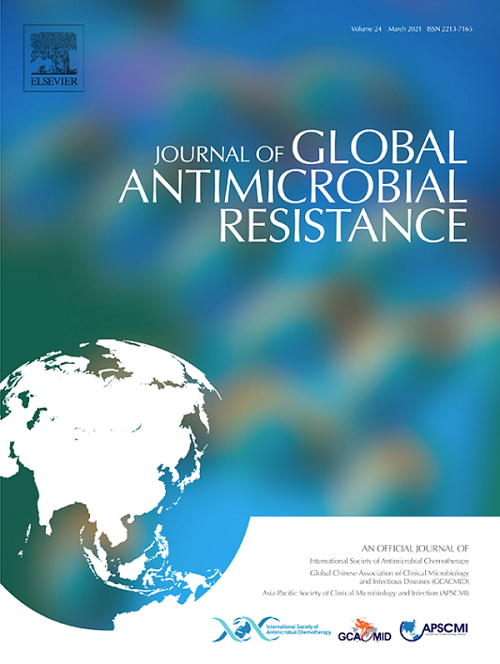Global and regional trends in Clostridioides difficile infection: An analysis from 1990 to 2021
IF 3.7
3区 医学
Q2 INFECTIOUS DISEASES
引用次数: 0
Abstract
Objectives
The epidemiological situation of Clostridioides difficile infection (CDI) has dramatically changed over the past 30 years, but few studies have systematically analysed changes in the global epidemic landscape. This study aimed to delineate the global, regional, and national burden of CDI from 1990 to 2021.
Methods
CDI data were derived from the Global Burden of Disease Study 2021. Joinpoint regression analysis assessed changes over time and calculated annual percentage change (APC) statistics. An age-period-cohort model was adopted to estimate net/local drifts as well as the age, period, and cohort effects of CDI mortality. The relationship between the sociodemographic index (SDI) and antibiotic use and disease burden was analysed.
Results
The age-standardised death rate (ASDR) increased from 0.10 per 100,000 persons in 1990 to 0.19 per 100,000 persons in 2021, with an estimated annual percentage change of 2.76 (95% confidence interval [CI]: 2.18, 3.33). The ASDR of global CDI exhibited an upward trend from 1990 to 2021, with an AAPC of 2.26 (95% CI: 1.77, 2.76), but a downward trend from 2017 to 2021, with an APC of -2.04 (95% CI: -3.17, -0.90). Antibiotic use was significantly positively associated with CDI burden. The defined daily dose of all antibiotic use per 1000 inhabitants was positively correlated with ASDRs in high, high-middle, and low SDI regions (P < 0.001, P < 0.001, and P < 0.001, respectively).
Conclusions
The burden of CDI has increased globally from 1990 to 2021, revealing significant spatial disparities. Antibiotic use is positively associated with CDI mortality.
艰难梭菌感染的全球和区域趋势:1990年至2021年的分析
目的艰难梭菌感染(clostridiides difficile, CDI)的流行病学形势在过去30年中发生了巨大变化,但很少有研究系统地分析了全球流行格局的变化。本研究旨在描述1990年至2021年全球、地区和国家CDI负担。方法scdi数据来自2021年全球疾病负担研究。连接点回归分析评估了随时间的变化,并计算了年度百分比变化(APC)统计数据。采用年龄-时期-队列模型来估计净/局部漂移以及年龄、时期和队列对CDI死亡率的影响。分析了社会人口学指数(SDI)与抗生素使用和疾病负担的关系。结果年龄标准化死亡率(ASDR)从1990年的0.10 / 10万人增加到2021年的0.19 / 10万人,估计年百分比变化为2.76(95%置信区间[CI]: 2.18, 3.33)。全球CDI的ASDR从1990年到2021年呈上升趋势,AAPC为2.26 (95% CI: 1.77, 2.76),但从2017年到2021年呈下降趋势,APC为-2.04 (95% CI: -3.17, -0.90)。抗生素使用与CDI负担显著正相关。在SDI高、中高和低地区,每1000名居民中所有抗生素使用的限定日剂量与asdr呈正相关(P <;0.001, P <;0.001, P <;分别为0.001)。结论1990 - 2021年全球CDI负担呈上升趋势,且存在显著的空间差异。抗生素使用与CDI死亡率呈正相关。
本文章由计算机程序翻译,如有差异,请以英文原文为准。
求助全文
约1分钟内获得全文
求助全文
来源期刊

Journal of global antimicrobial resistance
INFECTIOUS DISEASES-PHARMACOLOGY & PHARMACY
CiteScore
8.70
自引率
2.20%
发文量
285
审稿时长
34 weeks
期刊介绍:
The Journal of Global Antimicrobial Resistance (JGAR) is a quarterly online journal run by an international Editorial Board that focuses on the global spread of antibiotic-resistant microbes.
JGAR is a dedicated journal for all professionals working in research, health care, the environment and animal infection control, aiming to track the resistance threat worldwide and provides a single voice devoted to antimicrobial resistance (AMR).
Featuring peer-reviewed and up to date research articles, reviews, short notes and hot topics JGAR covers the key topics related to antibacterial, antiviral, antifungal and antiparasitic resistance.
 求助内容:
求助内容: 应助结果提醒方式:
应助结果提醒方式:


